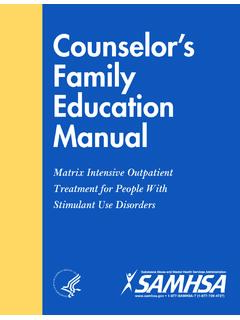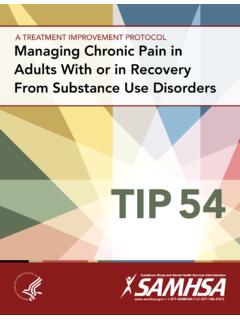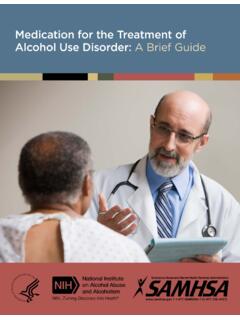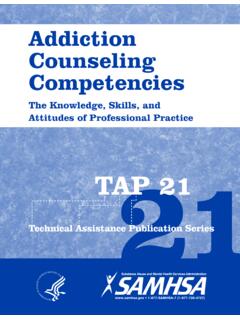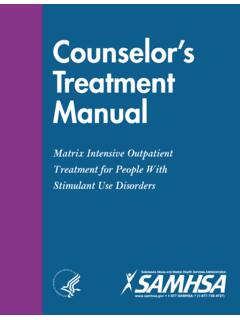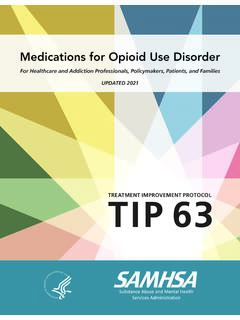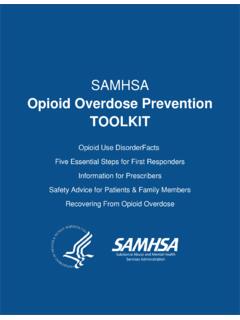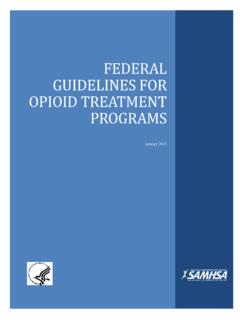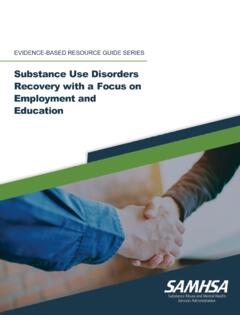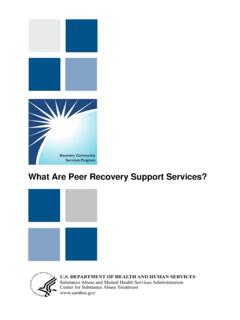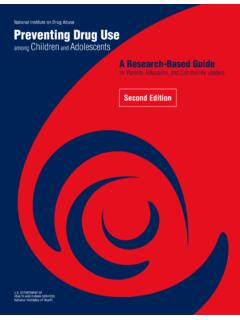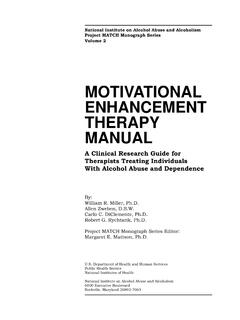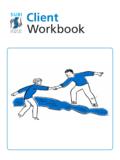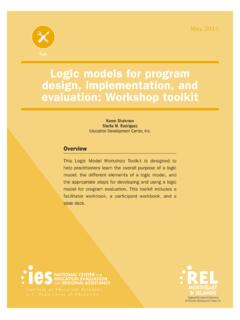Transcription of TIP 51 Substance Abuse Treatment Addressing the Specific ...
1 Substance Abuse Treatment : Addressing the Speci c Needs of Women A Treatment Improvement Protocol TIP. 51. Substance Abuse Treatment : Addressing the Specific Needs of Women A Treatment Improvement Protocol TIP. 51. DEPARTMENT OF HEALTH AND HUMAN SERVICES. Public Health Service Substance Abuse and Mental Health Services Administration 1 Choke Cherry Road Rockville, MD 20857. Acknowledgments Recommended Citation This publication was prepared under contract Substance Abuse and Mental Health Services numbers 270-99-7072 and 270-04-7049 by the Administration. Substance Abuse Treatment : Knowledge Application Program (KAP), a Joint Addressing the Specific Needs of Women. Treat.
2 Venture of The CDM Group, Inc., and JBS ment Improvement Protocol (TIP) Series, No. International, Inc., for the Substance Abuse 51. HHS Publication No. (SMA) 13-4426. Rock . and Mental Health Services Administration ville, MD: Substance Abuse and Mental Health (SAMHSA), Department of Health and Hu Services Administration, 2009. man Services (HHS). Andrea Kopstein, , , Karl D. White, , and Christina Currier served as the Contracting Officer's Rep Originating Office resentatives. Quality Improvement and Workforce Develop . ment Branch, Division of Services Improve . Disclaimer ment, Center for Substance Abuse Treatment , Substance Abuse and Mental Health Services The views, opinions, and content of this publi Administration, 1 Choke Cherry Road, Rock.
3 Cation are those of the author and do not neces ville, MD 20857. sarily reflect the views, opinions, or policies of SAMHSA or HHS. HHS Publication No. (SMA) 13-4426. Public Domain Notice First Printed 2009. All material appearing in this report is in the Revised 2010, 2012, and 2013. public domain and may be reproduced or copied without permission from SAMHSA. Citation of the source is appreciated. However, this publica . tion may not be reproduced or distributed for a fee without the Specific , written authorization of the Office of Communications, SAMHSA, HHS. Electronic Access and Copies of Publication This publication may be ordered from or downloaded from SAMHSA's Publications Ordering Web page at Or, please call SAMHSA at 1-877-SAMHSA-7.
4 (1-877-726-4727) (English and Espa ol). ii Please share your thoughts about this publication by completing a brief online survey at: The survey takes about 7 minutes to complete and is anonymous. Your feedback will help SAMHSA develop future products. Contents What Is a TIP? .. vii Consensus Panel ..ix Editorial KAP Expert Panel and Federal Government Participants .. xiii xv Executive xvii Chapter 1 Creating the Context .. 1. Creating the Context ..1. Gender Responsive Treatment Principles ..4. Women's Biopsychosocial Organization of This TIP .. 15. Chapter 2 Patterns of Use: From Initiation to Treatment ..17. 17. Initiation of Use Among Women .. 18. Risk Factors Associated with Initiation of Substance Use and the Development of Substance Use Disorders Among 18.
5 Patterns and Prevalence of Substance Use Among 26. Prevalence of Substance Abuse and Dependence Among Women .. 30. Chapter 3 Physiological Effects of Alcohol, Drugs, and Tobacco on 37. Physiological Effects and Consequences of Substance Abuse In Women .. 38. Physiological Effects: Factors of 38. Physiological Effects of Alcohol .. 40. Physiological Effects of Licit and Illicit 46. Physiological Effects of Tobacco Use .. 48. Effects of Alcohol, Drugs, and Tobacco Use on Pregnancy and Birth Outcomes .. 48. Effects of Alcohol and Illicit Drugs on HIV/AIDS 52. Chapter 4 Screening and Assessment ..57. 57. The Difference Between Screening and Assessment .. 58. Screening and Assessment: Factors of Influence.
6 58. Contents iii Screening .. 60. Assessment .. 74. Chapter 5 Treatment Engagement, Placement, and 83. Barriers to Treatment Engagement .. 83. Treatment Engagement 87. Considerations in Treatment Placement and Planning .. 92. Levels of Care .. 92. Chapter 6 Substance Abuse Among Specific Population Groups and Settings ..103. Racially and Ethnically Diverse Women ..104. Sexual Orientation and Women Later in Life ..127. Women in Rural America ..130. Resources for Other Special Populations and Settings ..133. Women in the Criminal Justice Women Who Are Homeless ..135. Chapter 7 Substance Abuse Treatment for Women ..137. Treatment Retention ..137. Women's Treatment Issues and Addressing Tobacco Use with Women in Chapter 8 Recovery Management and Administrative Considerations.
7 181. Continuing Care ..181. Treatment Outcome ..182. Support Systems for Women ..186. Administrative Appendix A: Appendix B: CSAT's Comprehensive Substance Abuse Treatment Model for Women and Their Children ..273. Appendix C: Screening and Assessment Appendix D: Allen Barriers to Treatment Instrument ..307. Appendix E: DSM-IV-TR Criteria for Posttraumatic Stress Disorder ..311. Appendix F: Integration Self-Assessment for Appendix G: Resource Panel Appendix H: Cultural Competency and Diversity Network Appendix I: Field Appendix J: Index ..335. iv Contents Figures 1-1 A Woman's Life in Context ..3. 1-2 Interrelated Elements in the Comprehensive Treatment Model ..4. 2-1 Use of Illicit Drugs, Alcohol, or Tobacco by Females Aged 12 or Older, Past Year and Past Month, Numbers in Thousands and Percentages, 2006.
8 29. 2-2 Past Month Substance Use, Based on Combined 2006 and 2007 Data: National Survey on Drug Use and Health (NSDUH) .. 30. 2-3 Percentages of Past-Year Abuse of or Dependence on Alcohol or Any Illicit Drug by Gender and Age, 2006 .. 31. 2-4 Percentages of Past-Year Abuse of or Dependence on Alcohol or Any Illicit Drug Among Women Aged 18 or Older by Age Group: 2003 .. 32. 2-5 Percentage of Admissions to Substance Abuse Treatment Programs by Racial/Ethnic Group in 2006 .. 33. 2-6 Primary Substance of Abuse Among Women Admitted for Substance Abuse Treatment by Racial/Ethnic Group by Percentage.. 34. 4-1 The CAGE Questionnaire .. 62. 4-2 The TWEAK Questionnaire: Women.
9 64. 4-3 The T-ACE Questionnaire .. 64. 4-4 5Ps Screening .. 65. 4-5 Questions to Screen for Trauma History .. 69. 4-6 Questions Regarding Sexual Abuse .. 71. 4-7 STaT: Intimate Partner Violence Screening Tool .. 72. 4-8 General and Specific Screening Questions for Persons with Possible Eating Disorders .. 73. 4-9 Available Screening and Assessment Tools in Multiple Languages .. 80. 5-1 Percentages of Reasons for Not Receiving Substance Use Treatment in the Past Year Among Women Aged 18 49 Who Needed Treatment and Who Perceived a Need for It: 2004 2006 .. 85. 5-2 PROTOTYPES .. 91. 5-3 Services Needed in Women's Substance Abuse Treatment .. 93. 6-1 Group Therapy: Promising Practices and Strategies for African-American 7-1 Violence and Women.
10 156. 7-2 PTSD Symptoms ..162. 7-3 Helpful Skills for Trauma Victims ..163. 7-4 Common Definitions of Eating Disorders and Behaviors ..175. 8-1 Women- Specific Predictors of Relapse and Reactions to Relapse ..184. 8-2 Women's Recovery Group: Manual-Based Relapse Prevention ..185. 8-3 Goals and Training Guidelines for Point-of-Entry Staff (Non Substance - Abuse Treatment Providers) ..190. 8-4 Goals and Training Guidelines for Substance Abuse Treatment Counselors ..191. 8-5 State Standard Examples of Gender- Specific Treatment ..195. B-1 Interrelated Elements in the Comprehensive Treatment Model ..276. B-2 Elements of Clinical Treatment B-3 Elements of Clinical Support Services.
